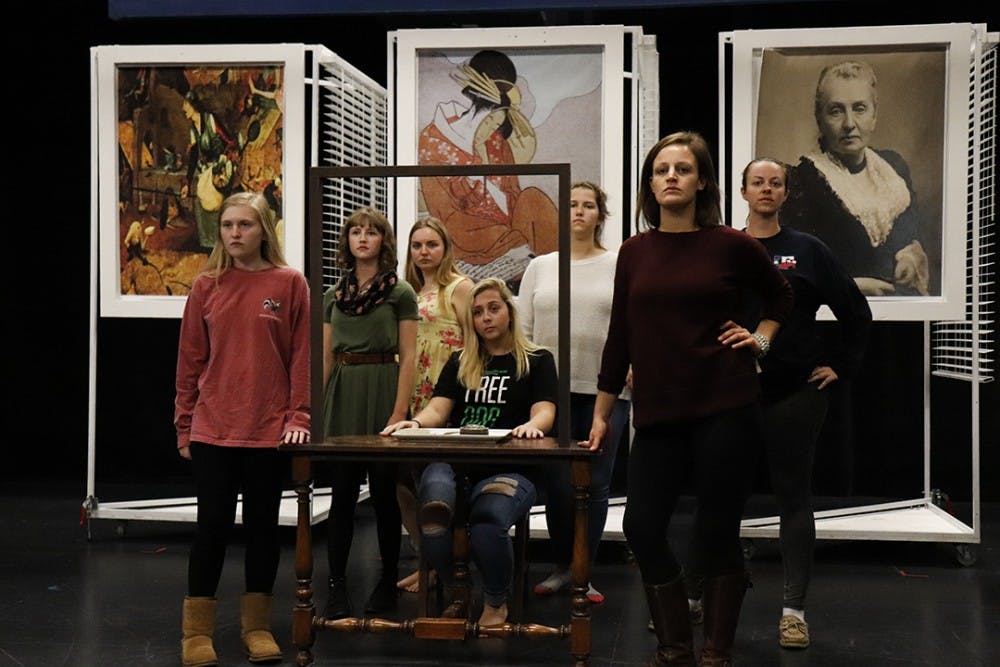Opening this past Thursday night and continuing through Nov. 4, the USC Department of Theatre and Dance will perform “Top Girls,” a feminist play written by Caryl Churchill. Directed by Lindsay Rae Taylor, this performance responds to the question of what it takes for a woman to succeed in a world made for men.
Churchill wrote “Top Girls” in response to the election of Great Britain’s first female prime minister, Margaret Thatcher. While most people focused on Thatcher’s achievement as a female, Churchill only noted what Thatcher’s conservative politics would mean for the country.
From her hesitancy to celebrate Thatcher’s success at the misfortune of the less fortunate, “Top Girls” was born. Even though it is set in the 1980s, Churchill’s themes still have a notable application for today.
Before stepping into the Center for Performance Experiment, I wasn’t very familiar with this play. If the same applies to you, it might seem a little confusing in the beginning. The surreal first act starts with a party. Marlene, played by Kimberly Braun, is a businesswoman living in London. At the opening of the play, she has invited a group of women for dinner to celebrate her recent promotion.
The women invited to this dinner party are all wearing clothes from different eras, and it turns out it is because they are from entirely different time periods. They talk over each other, having multiple conversations at once, to the point where it can be hard to follow at times.
However, after getting accustomed to the dialogue pattern, this made the play feel more real. Instead of very staged conversations with only one person speaking at a time, this fluid dynamic followed that of an ordinary dinner party. Side conversations, over talkative guests and the dinner goer that drinks a little too much, all found their place, with the cast falling into their roles with ease.
The theme becomes more apparent before the end of the supper: these are all women who faced adversity at the hands of the men in their lives. A female Pope from the ninth century, a Japanese courtesan and a female warrior, among others, might not seem to have many similarities on the surface, but all rose in places men never expected or wanted them to.
The other acts continue to follow Marlene and develop new characters, but they don’t have the same surrealistic moments like the first. All the women the audience become familiar with at the dinner party go to entirely new places as women in London circa 1980 as the play unfolds. The cast adopted these new roles so easily that there was no confusion about the different characters.
Focusing on the Top Girls’ Employment Agency, the audience sees these new characters looking for change, but ultimately not finding it. Instead of getting what they wanted, they are offered lesser jobs more suited for their places as women in Thatcher’s society. As we see their suggestions for new careers being shot down time and again, a feeling of discouragement on where women stand in the workplace festers in the audience.
However, as this is happening, Marlene develops into Thatcher’s fictional counterpart: a woman who will do what it takes to rise up in a male-dominated society. At times she is ridiculed and even hated for not being what other women expect her to be, for not taking enough responsibility in her family. Even so, we also see her stand up to those who say she shouldn’t work above men.
Marlene develops more independent tendencies in her search of achievement — she shirks her responsibilities as a mother and doesn’t care about those she leaves behind. These other women, who still care about those aspects of their lives, aren’t able to get near the same position Marlene does. These two perspectives begin to make the audience question how this opposition can be fixed.
In the end, the play asks if it is worth it for women to give up their feminine characteristics — their loving, female-supporting pride, to rise up with men? This is not a question Churchill, Taylor or the cast answers, but it is one the audience is expected to answer for themselves.
“Top Girls” was brilliantly conceived by Taylor and the entire cast and crew. As an audience member, you are transported from a theater in Columbia to a place that only these characters and their emotions can inhabit. This is a play that asks instead of answers, and it will leave the audience with a new feeling about the world around them.

